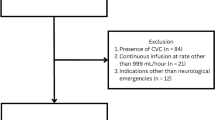Summary
Acute cerebrovascular congestion after a closed head injury is significantly related to intracranial hypertension. As an indirect method of cerebral blood flow measurement, transcranial doppler sonography (TCD) provides a rapid and noninvasive assessment of cerebral haemodynamics, including hyperaemic conditions.
TCD examinations was serially performed in 35 patients with severe head injury with intact cerebral circulation; i.e. the mean flow velocity (MFV) patterns of the middle cerebral artery (MCA) did not show signs of cerebral circulatory arrest such as systolic spike, to and fro, or no flow. The results showed that the MFV of the MCAs and ipsilateral extracranial internal carotid arteries (ICAs) in 9 of these patients increased sharply and pulsatility index (PI) decreased during 48–96 hours after the injury. This was soon followed by patterns of high intracranial resistance, consistent with elevated intracranial pressure (ICP) in monitored patients and acute brain swelling on repeated computed tomographic (CT) scans. The correlation between increased MFVs, decreased PIs, and cerebral haemodynamic changes leading to acute brain swelling is discussed.
The number of patients who ended with severe disability, vegetative state, or death was 66% in this group of 9 patients, compared to only 34% for the 35 patients overall with severe head injury. Though the morbidity and mortality rates largely depend on the primary injury, the presence of acute cerebral swelling aggravate the grave course in these patients. And the ability of TCD to monitor the hyperaemic state prior to oedema should lead us to adjust the therapy in order to minimize the secondary insult related to intracranial hypertension.
Similar content being viewed by others
References
Aaslid R (ed) (1976) Transcranial Doppier sonography. Springer, Wien New York
Aaslid R, Markwalder T-M, Nornes H (1982) Noninvasive transcranial Doppter recording of flow velocity in basal cerebral arteries. J Neursurg 57: 769–774
Bishop CCR, Powell S, Rutt D, Browse NL (1986) Transcranial Doppler measurement of middle cerebral artery blood flow velocity: a validation study. Stroke 17: 913–915
Bruce DA, Langfitt TW, Miller JD, Shutz A, Valpalahti MP, Stanek A, Goldberg H (1973) Regional cerebral blood flow, intracranial pressure, and brain metabolism in comatose patients. J Neurosurg 38: 131–144
Bruce DA, Raphaely RC, Goldberg AI, Zimmerman RA, Bilaniuk LT, Schut L, Kuhl DE (1979) Pathophysiology, treatment and outcome following severe head injury in children. Childs Brain 5: 174–191
Bruce DA, Alavi A, Bilaniuk L, Dolinskas C, Obrist W, Uzzell B (1981) Diffuse cerebral swelling following head injuries in children: the syndrome of “malignant brain oedema”. J Neurosurg 54: 170–178
Gomez CR, Backer RJ, Bucholz RD (1991) Transcranial Doppler ultrasound following closed head injury: vasospasm or vasoparalysis? Surg Neurol 35: 30–35
Gosling RG, King DH (1974) Arterial assessment by Doppler-shift ultrasound. Proc R Soc Lond (Biol) 67: 447–449
Harders A (1986) Neurosurgical applications of transcranial Doppler sonography. Springer, Wien New York
Hassler W, Steinmetz H, Gawlowski J (1988) Transcranial Doppler ultrasonography in raised intracranial pressure and in intracranial circulatory arrest. J Neurosurg 68: 745–751
Hennerici M, Rautenberg W, Sitzer G, Schwartz A (1987) Transcranial Doppler ultrasound for the assessment of intracranial arterial flow velocity, part 1. Examination technique and normal values. Surg Neurol 27: 439–448
Yoshino E, Yamaki T, Higuchi T, Horikawa W, Hirakawa K (1985) Acute brain oedema in fatal head injury: analysis by dynamic CT scanning. J Neurosurg 63: 830–839
Kontos HA (1989) Validity of cerebral arterial blood flow calculations from velocity measurements. Stroke 20: 1–3
Lindegaard KF, Nories H, Bakke SJ, Sorteberg W, Nakstad P (1989) Cerebral vasospasm diagnosis by means of angiography and blood velocity measurements. Acta Neurochir (Wien) 100: 12–24
McHedlishvili G (1986) Arterial behaviour and blood circulation in the brain. Plenum, New York
McHedlishvili G (1988) Pathogenetic role of circulatory factors in brain oedema development. Neurosurg Rev 11: 7–13
Muizelaar JP, Marmarou A, De Salles AAF, Ward JD, Zimmerman RS, Li Z, Choi SC, Young HF (1989) Cerebral blood flow and metabolism in severely head-injured children. Part 1: relationship with GCS score, outcome, ICP and PVI. J Neurosurg 71: 63–71
Muizelaar JP, Ward JD, Marmarou A, Newton PG, Wachi A (1989) Cerebral blood flow and metabolism in severely head-injured children. Part 2: autoregulation: J Neurosurg 71: 72–76
Obrist WD, Langfitt TW, Jaggi JL, Cruz J, Genarelli TA (1984) Cerebral blood flow and metabolism in comatose patients with acute head injury. J Neurosurg 61: 241–253
Rozsa L, Grote EH, Egan P (1989) Traumatic brain swelling studied by computerized tomography and densitometry. Neurosurg Rev 12: 133–140
Shigemori M, Moriyama T, Harada K, Kikuchi N, Tokutomi T, Kuramoto S (1990) Intracranial hemodynamics in diffuse and focal brain injuries. Evaluation with transcranial Doppler (TCD) ultrasound. Acta Neurochir (Wien) 107: 5–10
Weber M, Grolimund P, Seiler RW (1990) Evaluation of posttraumatic cerebral blood flow velocities by transcranial Doppler ultrasonography. Neurosurgery 27: 106–112
Author information
Authors and Affiliations
Rights and permissions
About this article
Cite this article
Muttaqin, Z., Uozumi, T., Kuwabara, S. et al. Hyperaemia prior to acute cerebral swelling in severe head injuries: The role of transcranial doppler monitoring. Acta neurochir 123, 76–81 (1993). https://doi.org/10.1007/BF01476289
Issue Date:
DOI: https://doi.org/10.1007/BF01476289




